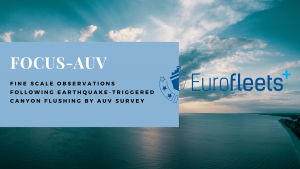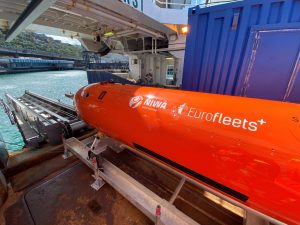
Following a very successful Eurofleets+ Transnational Access Call the FOCUSAUV (Fine scale Observations following earthquake-triggered Canyon flUShing by AUV) survey was successful in securing funding and will be implemented from September 30th to October 29th in New Zealand.
The survey is supported by the Eurofleets+ a H2020 funded project which facilitates open access to an integrated and advanced research vessel fleet, designed to meet the evolving and challenging needs of the user community.
This campaign brings together two Eurofleets+ Infrastructures, the RV Tangaroa – the flagship research vessel of New Zealand’s National Institute of Water and Atmospheric Research (NIWA) – and the autonomous underwater
vehicle (AUV) from Sweden’s University of Gothenburg (UGOT). NIWA will survey the Kaikōura canyon, off the east coast of the South Island, to measure the ecological and sedimentological impact and recovery following the
2016 Kaikōura Earthquake. The Kaikōura Canyon sits at the southern end of the Hikurangi subduction margin, an area that includes a broad range of dynamic seafloor processes related to active tectonics, sediment transport and
fluid flow.


Aodhán Fitzgerald, Eurofleets+ Project coordinator noted that the FOCUS AUV project was the ideal example to launch the Eurofleets+ Transnational access campaign, as it a clear representation of the Eurofleets+ project objective of cooperation, collaboration and interoperability to advance our knowledge of the ocean. He extended his thanks to both the technical and scientific teams for their extraordinary efforts to ensure that this cruise went ahead, against the odds, which not only demonstrates huge commitment to their individual fields but also to marine research. This pioneering campaign is one of 10 highly ranked research projects with ship-time and marine equipment granted through the SEA-Call “OCEANS”, these research projects will get access to a total of 114 days at sea fully funded by the Eurofleets+ project.
Two expert technicians from Sweden have joined the New Zealand scientists on the 29-day voyage with the objective to collect the maximum amount of data possible using the AUV. COVID restrictions have meant scientists from
other countries originally expected to be on the voyage, have been unable to travel to New Zealand.
Voyage leader and NIWA marine geologist Dr Joshu Mountjoy says the AUV will fly at 50 m above the seafloor enabling scientists to gather data at high resolution that has not previously been possible.
“We know there was a huge change in the canyon during the Kaikōura earthquake, but we don’t really know the details of how that change happened. We are really interested in the mechanisms of how the sediment was removed, and the changes to the biological habitats.”
Dr Mountjoy says the ability to access the Eurofleets+ will lead to huge leaps in understand of canyon processes. NIWA’s marine resources manager Rob Christie said this Eurofleets+ project had faced significant planning issues due to the COVID pandemic and he was grateful to both the team at The Marine Institute Ireland ‘Foras na Mara’
coordinating the Eurofleets + Project’s and UGOT for their dedication and vision for a more collaborative use of marine infrastructure.
The Eurofleets+ project aims to bring together an integrated and advanced research vessel fleet to enhance co-ordination and promote the cost-effective use of marine research infrastructure.
The FOCUS AUV project demonstrates the strong collaborative ties not only between scientists and their organisations but also from operators of research vessels and large interoperable marine equipment.
Such cooperation’s between European and International researcher’s support the objectives of Ocean Health and Blue Growth policies delivering interoperability of marine equipment across the fleet, increasing of operational efficiency’s by sharing best practice and implementing FAIR data management across all Transnational activity.
Download here the press release
